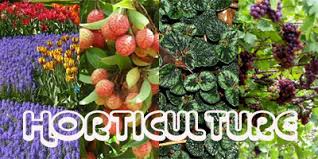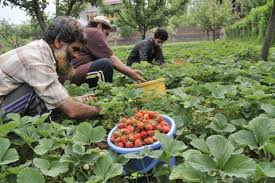HORTICULTURE

I bring to you today a branch of agriculture which is horticultural science. People have a wrong conception of what this branch of agriculture is, all they think when they hear the term horticulture is that it deals only with planting of flowers. Horticultural science is far more than the flower for beautification of surroundings alone, it is also spread into diverse fields and all this will be learnt in the section below.
DEFINITION
It is the science and art concerned with intensively cultured plants directly used by people for food, medicine and aesthetic gratification (environmental beatification).
Branches of horticulture include
floriculture (study of flower)
olericulture (study of vegetables)
pomology (study of fruits)
ornamental horticulture (landscaping)
horticultural engineering etc. of which olericulture and ornamental horticulture shall be discussed.

Importance of horticulture is:
Aesthetic/beautification of environment
Engineering purpose
Architectural purpose
Biological purpose
Ecological purpose
Economic purpose and Social purpose
OLERICULTURE: - This is the cultivation, production and management of vegetables. Vegetables are edible plant consumed in whole, parts, raw or with minimal cooking and can be used as supplements to starchy food.

Classification of vegetables
vegetables can be classified based on:
1)Edible portion: that is the leafy vegetable (amaranths spp.), fruit vegetables (okra, tomato, watermelon etc.), seed vegetables (melon), and root vegetables (carrot, ginger etc.).
2)Season or area of production: these are the warm season vegetables which respond to temperature between medium to high temperature positively i.e. (13-18oC to 18-24oC) e.g. Celosia spp., Amaranthus spp., Okra, Tomato etc. and the cool season vegetables which requires low to medium temperature for them to produce optimally i.e. (7-13oC to 13-18oC) e.g. carrot, cabbage, lettuce etc.
Factors affecting site selection in vegetable production
This includes:
climatic factors (temperature, rainfall, light and relative humidity)
soil factors (soil pH between 5-6.5 and topography)
human factors
seed factors etc.
Planting: Vegetables are usually planted on nursery beds which could be raised bed for raining season or sunken bed for dry season. Due to the tininess of vegetable seeds, they can be planted using the following method;
a) Broadcasting: Involves spreading seeds over the area that is to be planted. Mixing ratio is 5g of seeds to 1kg dry sand. This allows for good distribution of seed.
b) Drilling method: Involves planting of seeds in narrow lines and are covered lightly. This allows for easy management practices like weeding etc.
c) Transplanting method: This is usually done for vegetables that find it hard to develop under harsh condition. They are raised at the nursery stage at favorable conditions and seedlings are transplanted after 2-3weeks for Amaranthus spp. and Celosia spp., 3-4weeks for tomato and 5-6weeks for pepper. Transplanting is done at evening time to avoid root shock.
some important definitions to take note of:
Gardening
A piece of land where vegetables, ornamentals, fruits etc. are grown.
Nursery
A nursery is a piece of land where propagules and or seedlings meant for field establishment or sale are produced under intensive management. Types of nursery are ground nursery, polythene bag nursery and bench nursery. The factors to consider when using nursery are:
nursery duration
adequate water
soil conditions
accessibility
proximity to market
adequate land
availability of other inputs
absence of diseases and labor
Management practices in nurseries: includes layout and structures of the nursery, water management, light or shade management, sanitation and cleanliness and care of nursery tools and materials.
Plant propagation: This is the increase in number of individual of a species, usually accompanied by their spread over a given area. It can be accomplished either by Sexual (seeds) or Asexual (vegetative means- cuttings, layering, budding, grafting etc.).
Ornamental horticulture and landscaping:
It is the science and art of developing the out environment using ornamental plants and hard cape components to serve the needs and desires of people. It serves both the aesthetic and functional purposes. Landscaping involves design, construction and maintenance of landscapes.
Classes of ornamental plants include:
Hedges or screens: are dense foliage, perennial, have good branching ability, evergreen and are resistant to shearing e.g. Ixora javanica, Murraya paniculata etc.
Foundation plants: provides transition from house to garden by hiding the unattractive house foundation e.g. Euphorbia splendens, Canna indica etc.
Ground covers: mostly functions as barrier in landscape and also helps to prevent erosion e.g. Peperomia sandesii, Portulaca grandiflora etc.
Ornamental shrubs: range from ankle-height Lilliputians to multi-stemmed Gulliver, and are used as meadows and ornamental spot plants in an environment e.g. Thevethia peruviana, Thuja occidentalis etc.
Others includes Ornamental palms, Cut flowers and Indoor plants
CULTIVAR
Cultivars are group of plants with similar characteristics which can be used for the purpose of agriculture, forestry etc. Types include Clone, Inbred, F1 hybrid, F2 hybrid, Line and Open pollinated.
Selection of cultivar: this is the act of selective reproduction in a population due to the effect of human or natural forces i.e. it could natural or artificial.
Importance of mode of reproduction to selection:
It determines the genetic composition of a particular crop which in turn is the deciding factor to develop suitable breeding and selection method.
Its knowledge is also essential for artificial manipulation to breed improved types.
Selection of Cross-Pollinated Crop
Plants species with normal mode of seed set is through a high degree of cross pollination. They have characteristics reproductive features and pollination structure which are existence of self-fertility, self-incompatibility, imperfect flowers and mechanical obstruction which makes plants dependent on foreign pollen for normal seed set. There two types of selection of cross-pollinated crop which are
(1) Mass selection and
(2) Recurrent selection.
Breeding Asexually Propagated Crop
Asexual reproduction covers all those mode of reproduction when normal gamete formation and fertilization does not take place. Superior plants are selected and they undergo vegetative propagation, after which the vegetative offspring are used to develop stable varieties. This unique characteristic of asexual reproduction helps to produce or develop a number of cultivars of fruits and vegetables. Selection is done by selecting the best performing plant and the vegetative propagation.
FLOWER STRUCTURE
Flower can be defined as the reproductive part of a plant and types of flowers are usually based on their floral parts, sexual capability and based on their genetic structure.
Based on their floral parts we have:-
• Complete flower which has all the floral part present.
• Incomplete flower which has one of the floral part missing.
Based on their sexual capability we have:-
• Perfect flower: having both the male and female part in one plant.
• Imperfect flower: having male and female part on different plants.
Based on their genetic structure we have:-
• Homozygosity
• Heterozygosity.
Some flower parts include:-Ovaries, Sepals and Style.
ALL IMAGES ARE CREDITED TO GOOGLE SEARCH. THANKS OR YOUR TIME
You have received an upvote from @nicestbot. I am an automated curation bot trying to make minnows happy.